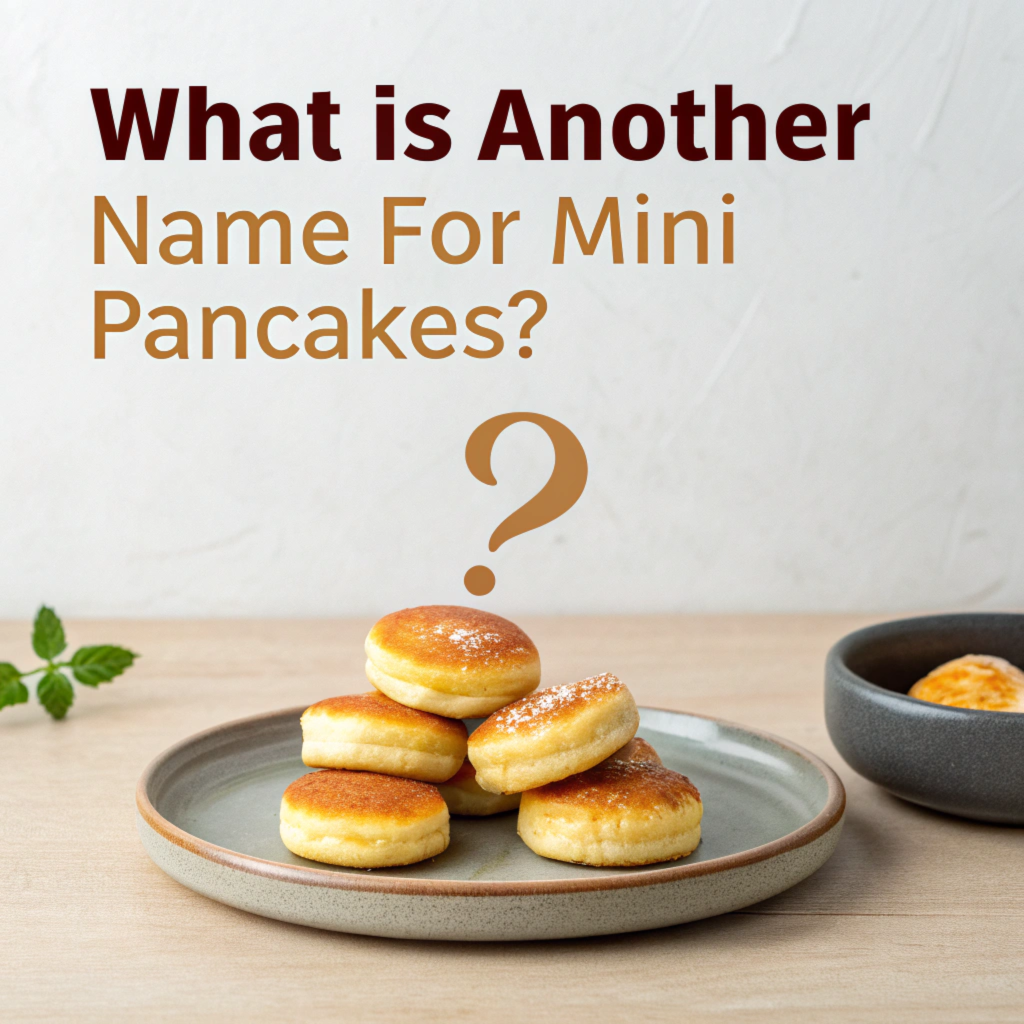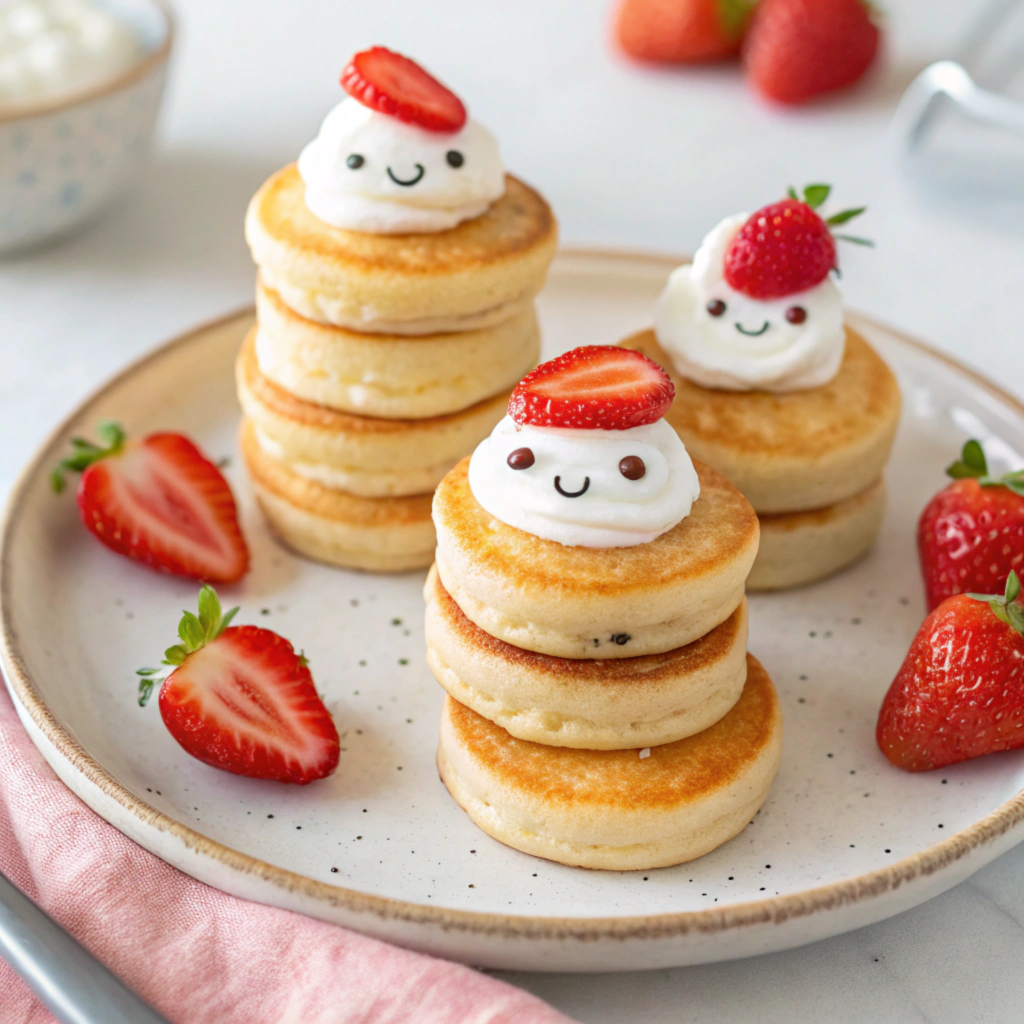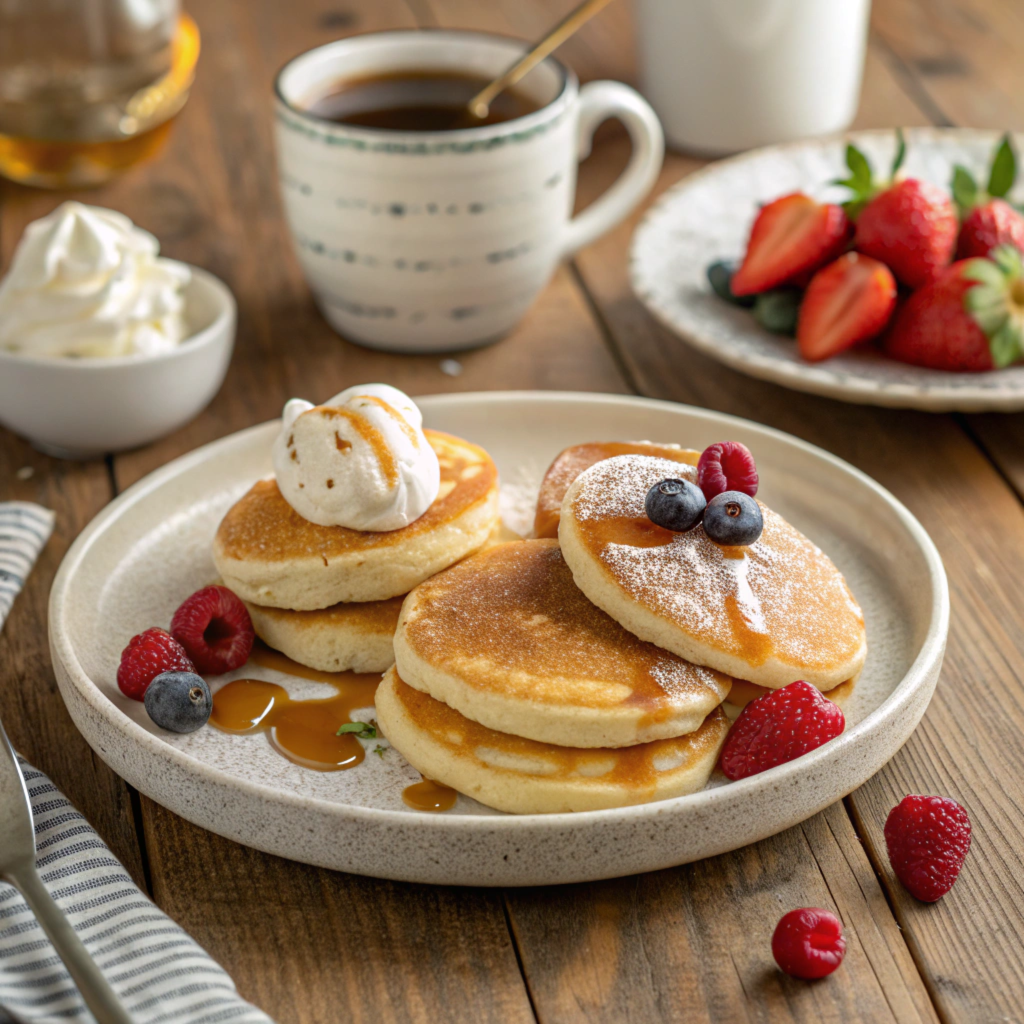
Mini pancakes, those bite-sized, fluffy treats, are enjoyed across the globe under various names. Their universal appeal lies in their delightful texture, quick cooking time, and versatility in both sweet and savory dishes. While “mini pancakes” is a common term, many cultures have unique names for these delicious treats, reflecting rich culinary histories and traditions.
Why Mini Pancakes Are Popular Worldwide
Mini pancakes have become a favorite due to their convenient size, appealing presentation, and adaptability to numerous recipes. Here’s why they are loved worldwide:
- Perfect for All Ages: Their small size makes them a hit with kids and adults alike.
- Versatile Serving Options: Serve them as breakfast, brunch, snacks, or dessert.
- Customizable Flavors: Add fruits, chocolate chips, or even savory ingredients like cheese or herbs.
- Quick and Easy to Make: Their small size allows for faster cooking and easy portioning.
- Great for Gatherings: Mini pancakes are perfect for parties, buffets, and special occasions, thanks to their eye-catching presentation.
Cultural Variations of Mini Pancakes
Though “mini pancakes” is a widely used term, several countries have their own versions, each with unique names and preparation styles:
- Dutch Poffertjes: Small, puffy pancakes made with yeast and buckwheat flour.
- Russian Blinis: Thin, small pancakes often served with sour cream and caviar.
- Japanese Dorayaki: A sweet pancake sandwich filled with red bean paste.
Each variation reflects the culinary traditions and tastes of its country of origin, showing the diversity of mini pancake culture worldwide.
Mini Pancakes in Breakfast and Dessert Menus
Mini pancakes have become a staple in global breakfast and dessert menus due to their flexibility. Here are some popular serving styles:
- Breakfast Buffets: Mini pancakes are commonly served with maple syrup, honey, and fresh fruits in breakfast spreads.
- Dessert Tables: Topped with whipped cream, chocolate sauce, and sprinkles, they transform into a delightful dessert.
- Cafe Menus: Many cafes feature mini pancakes as a trendy brunch item, often served with artisanal toppings.
- Street Food Stalls: In some countries, mini pancakes are sold as street food, freshly cooked and served hot.
Pro Tips for Enjoying Mini Pancakes
- Pair with Unique Toppings: Try exotic jams, flavored syrups, or spiced whipped cream.
- Experiment with Fillings: Make stuffed mini pancakes with chocolate, caramel, or fruit compote.
- Create a Pancake Bar: Set up a mini pancake bar at parties with various toppings for guests to customize.
- Try International Variations: Experience different global styles by trying recipes from various countries.
Conclusion
Mini pancakes are more than just a breakfast favorite. They are a global culinary phenomenon, cherished under different names and served in countless creative ways. Whether you call them poffertjes, blinis, or simply mini pancakes, they remain a delicious and versatile treat enjoyed by people of all cultures.
Different Names for Mini Pancakes by Region
Mini pancakes carry different names across the globe, reflecting the unique culinary traditions of each region. Cultural heritage, traditional recipes, and preparation techniques all influence these names. Let’s explore some popular terms used for mini pancakes worldwide.
European Names for Mini Pancakes
1. Poffertjes (Netherlands): Dutch Mini Pancakes
The Dutch refer to their beloved mini pancakes as poffertjes. These small, fluffy pancakes feature a soft, spongy texture created by a mixture of wheat and buckwheat flour. Cooks typically prepare poffertjes using a special pan with shallow molds that form their iconic round shape. Vendors often serve them hot with powdered sugar and butter at fairs and street markets, enhancing their appeal.
2. Blinis (Russia): Savory Mini Pancakes
Russians enjoy blinis as a traditional dish during festive celebrations. Made from buckwheat or wheat flour, blinis frequently appear as a savory appetizer topped with sour cream, smoked salmon, and caviar. Their thin, delicate texture and versatile flavor profile make them a popular choice for special occasions.
3. Scotch Pancakes (Scotland): Fluffy Pancake Treats
Scots call their version of mini pancakes “Scotch pancakes” or “drop scones.” These small, thick pancakes have a denser consistency than traditional American pancakes. People often serve them with butter, jam, or honey alongside tea, making them a favorite snack for afternoon breaks.
4. Oladushki (Eastern Europe): Fluffy Pancakes
In Eastern Europe, particularly in Russia and Ukraine, locals prepare oladushki using a blend of flour, eggs, and buttermilk. These thick, fluffy pancakes commonly appear with toppings like jam, honey, or sour cream, creating a delicious breakfast or dessert option.
American Names for Mini Pancakes
1. Silver Dollar Pancakes: Breakfast Favorites
In the United States, diners commonly serve “silver dollar pancakes.” This name originates from their small, coin-like size. These pancakes frequently appear in breakfast menus, stacked high with syrup, butter, and fruits for a classic American breakfast experience.
2. Mini Flapjacks: A U.S. Pancake Term

Americans also refer to mini pancakes as “mini flapjacks.” This term appears often in diners and family-style restaurants. While flapjacks typically refer to larger, thin pancakes, the “mini” version has become a beloved breakfast staple.
Asian Names for Mini Pancakes
1. Hotcakes (Japan): Sweet Pancake Treats
Japanese cafes frequently serve “hotcakes,” which are thick, fluffy pancakes similar to mini pancakes. The batter often contains baking powder, which helps create their signature height and airy texture. Popular toppings include whipped cream, fresh fruit, and sweet syrups.
2. Dorayaki (Japan): Pancake Sandwiches
In Japan, dorayaki consists of two small pancakes filled with sweet red bean paste. Although this snack differs from traditional mini pancakes, its pancake-like appearance and soft texture have earned it a spot in the mini pancake family.
3. Bánh Kẹp Lá Dứa (Vietnam): Pandan Pancakes
Vietnamese cooks make bánh kẹp lá dứa using pandan leaf extract, giving these pancakes a unique green hue and sweet, floral aroma. People often enjoy them as snacks or desserts.
Why Names for Mini Pancakes Vary
Cultural and culinary influences determine how regions name their versions of mini pancakes. Here are some reasons why the names differ:
- Cooking Techniques: Special pans, molds, and preparation styles create unique textures and forms.
- Local Ingredients: Regional flours, toppings, and flavorings influence recipes.
- Festive Traditions: Many cultures link their pancake recipes to holidays, celebrations, and food festivals, adding historical significance.
Conclusion
The names for mini pancakes may differ worldwide, but their deliciousness remains universal. Whether you try Dutch poffertjes, Russian blinis, or American silver dollar pancakes, each version showcases cultural richness through its preparation and presentation. Exploring these names reveals how culinary traditions connect people globally.
Mini Pancakes in International Cuisine
Mini pancakes are more than just a breakfast favorite—they hold cultural significance worldwide. Various countries have their unique versions of mini pancakes, often linked to traditional celebrations, street food culture, and restaurant menus. Let’s explore how mini pancakes feature prominently in international cuisine.
Festivals and Street Food Delights
1. Dutch Poffertjes at Food Markets
In the Netherlands, poffertjes are a staple at street food markets and fairs. Vendors cook these small, puffy pancakes on a specially designed pan with shallow molds. They serve poffertjes fresh off the pan, topped with melted butter and a dusting of powdered sugar. During winter holidays, poffertjes stands become popular spots, offering warmth and comfort through these sweet treats.
2. Russian Blinis at Traditional Celebrations
Blinis, Russia’s version of mini pancakes, hold a significant place in cultural celebrations like Maslenitsa, a week-long Russian festival marking the end of winter. Cooks serve blinis with various toppings such as sour cream, smoked fish, and caviar. This tradition symbolizes warmth, prosperity, and the arrival of spring.
3. Japanese Dorayaki at Festivals
Dorayaki, a popular Japanese treat made from two small pancakes filled with sweet red bean paste, often appears at Japanese cultural festivals and food stalls. Its sweet, satisfying taste makes it a beloved dessert among locals and visitors alike.
4. Pancake Day in the UK
Pancake Day, also known as Shrove Tuesday in the UK, features pancakes of all sizes, including mini versions. Families gather to make and enjoy pancakes with toppings like lemon juice and sugar. Though regular-sized pancakes dominate the event, mini pancakes have gained popularity for their fun, bite-sized appeal.
Restaurant Menus and Cafés Worldwide
1. Pancake Bites and Breakfast Specials
Many international cafés and restaurants now feature mini pancakes as part of their breakfast and brunch menus. In the United States, mini pancakes frequently appear as “silver dollar pancakes,” served with syrup, butter, and fruits. Restaurants often offer creative variations, pairing them with gourmet toppings like mascarpone, candied nuts, and artisan jams.
2. Global Pancake Chains Featuring Mini Pancakes
Global pancake chains have embraced the popularity of mini pancakes by including them in seasonal specials or children’s menus. IHOP, a famous international pancake chain, regularly features “Pancake Bites” or “Mini Pancake Stacks,” served with syrup and fruit toppings.
3. Artisan Cafés with Gourmet Pancakes
Artisan cafés in cities around the world have reinvented mini pancakes as high-end brunch items. These establishments serve mini pancakes with a gourmet twist, using toppings like caramelized bananas, espresso-flavored syrups, or edible flowers. This culinary creativity has elevated mini pancakes from casual street food to refined dining options.
Home-Cooked Favorites Across the Globe

Many families around the world prepare mini pancakes at home for special breakfasts, weekend brunches, or dessert. Each culture has its way of making and enjoying them:
- In Eastern Europe: Families make oladushki, topped with fruit preserves or sour cream.
- In the U.S.: Silver dollar pancakes are a family favorite, often made on Sunday mornings.
- In Japan: Home cooks prepare fluffy Japanese hotcakes, sometimes adding matcha or fruit-flavored syrups.
Why Mini Pancakes Are Culturally Significant
Mini pancakes play an essential role in culinary traditions worldwide because they are:
- Symbolic of Prosperity: In many cultures, round foods symbolize wealth and fortune.
- Versatile in Flavor: Mini pancakes can be sweet or savory, making them suitable for various meals.
- Family-Friendly: They bring people together, often prepared during family gatherings or festive celebrations.
- Culinary Showpieces: Many chefs use mini pancakes as a base for creative culinary masterpieces.
Conclusion
From street markets in the Netherlands to gourmet cafés in the U.S., mini pancakes have become a beloved global treat. They connect people through shared culinary traditions while reflecting the unique flavors and customs of each culture. Whether served as a festival snack, a brunch delicacy, or a home-cooked treat, mini pancakes remain a timeless favorite in international cuisine.
Why Mini Pancakes Have Different Names
Mini pancakes are a universal delight, but their names vary across cultures due to regional traditions, historical origins, and culinary branding. Each name reflects unique preparation methods, local ingredients, and cultural influences. Let’s explore the key reasons behind these diverse names.
Cultural and Historical Origins
1. Traditional Recipes Passed Down Generations
Many names for mini pancakes stem from age-old recipes passed down through generations. For instance, poffertjes from the Netherlands have been a beloved treat since the 18th century, prepared using specialized pans. Similarly, blinis from Russia have roots in ancient Slavic traditions, symbolizing the sun’s warmth during spring festivals. These recipes retain their original names, preserving their cultural heritage.
2. Local Ingredients and Cooking Styles
Ingredients available in specific regions play a significant role in naming mini pancakes. In Eastern Europe, pancakes made with buckwheat flour are known as blinis, while oladushki use wheat or rye flour. In Vietnam, bánh kẹp lá dứa gets its name from the use of pandan leaf extract, giving the pancakes a unique green hue and sweet aroma.
3. Regional Variations and Celebrations
Mini pancakes often gain names linked to regional festivals or customs. In the UK, Pancake Day celebrations have popularized many small pancake recipes, though they lack specific names. In Russia, blinis are a staple during Maslenitsa, while poffertjes appear at Dutch street markets and winter festivals.name their versions of mini pancakes
Commercial Branding and Marketing Influence
1. Pancake Mix Brands Naming Their Products
Many names for mini pancakes come from commercial branding efforts. Popular breakfast chains like IHOP, Denny’s, and other global brands feature “silver dollar pancakes” and “pancake bites” on their menus. These branded names often simplify the dish for marketing purposes while making it more appealing to global audiences.
2. Cafés Creating Unique Menu Labels
Artisan cafés and modern breakfast restaurants frequently rename mini pancakes with creative, trend-driven names. For example:name their versions of mini pancakes
- “Pancake Pops” – Pancakes served on skewers.
- “Fluffy Bites” – Mini pancakes served with whipped cream and fruit.
- “Sweet Stacks” – A playful term for small pancake stacks.
These custom names help businesses stand out in a competitive food industry by offering Instagram-worthy menu items that attract customers.
3. Cultural Fusion and Global Trends
With the rise of global food fusion, some mini pancake dishes have merged with other culinary traditions. In Japan, dorayaki, a pancake sandwich filled with sweet bean paste, blends Japanese and Western dessert styles. Similarly, food bloggers and influencers often invent trendy names like “Pancake Towers” or “Mini Pancake Platters”, shaping how the dish is marketed worldwide.name their versions of mini pancakes
Language and Translation Differences
1. Native Language Influence
In many regions, pancake names are directly tied to their native languages. For example, “poffertjes” is a Dutch word, while “blinis” comes from Russian. These names don’t translate easily into English, so they are often kept unchanged, preserving their cultural identity.
2. Adaptations for International Menus
International restaurants sometimes adapt mini pancake names to be more familiar to local customers. For example, Japanese hotcakes are often called “fluffy pancakes” when featured on Western menus, making them easier to market globally.
Why Names Persist Through Time
The enduring popularity of mini pancakes comes from both cultural traditions and modern food branding. Names like “silver dollar pancakes”, “blinis”, and “poffertjes” persist because they connect people to cherished memories, culinary heritage, and shared cultural experiences. Meanwhile, commercial food branding continues to create new names that appeal to modern tastes.name their versions of mini pancakes
Conclusion
The names for mini pancakes reflect rich culinary histories, diverse cultural traditions, and innovative marketing trends. Whether traditional or trendy, these names add flavor to the story of how mini pancakes have become a global favorite. Exploring these names reveals how food connects people across different cultures while celebrating unique flavors and cooking styles.name their versions of mini pancakes
name their versions of mini pancakes